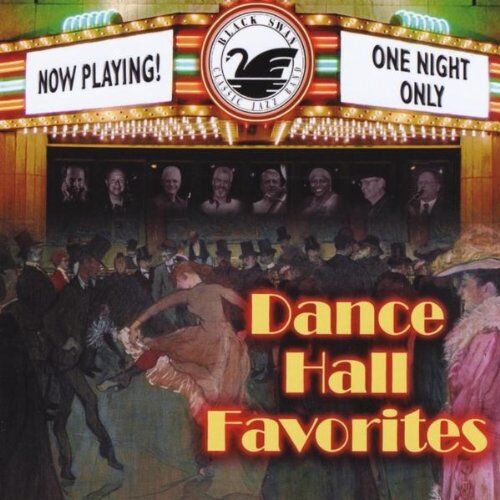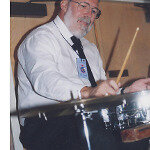 With this double CD, Kit Johnson and the Black Swan Classic Jazz Band are on solid ground by aiming the contents at dancers, as is suggested by the album’s title: Dance Hall Favorites. From its earliest days, it seems, traditional jazz has been danced to, although in the UK in the 1940s many devotees frowned upon such activities, preferring to sit listening only, brows furrowed in studious concentration.
With this double CD, Kit Johnson and the Black Swan Classic Jazz Band are on solid ground by aiming the contents at dancers, as is suggested by the album’s title: Dance Hall Favorites. From its earliest days, it seems, traditional jazz has been danced to, although in the UK in the 1940s many devotees frowned upon such activities, preferring to sit listening only, brows furrowed in studious concentration.
When Graeme Bell and his Australian Jazz Band visited Britain in 1948, they encouraged dancing (again) to the music (somewhat to the dismay of the intellectuals). Traditional jazz never lost its appeal to dancers in the US, if the Dawn Club in San Francisco is any indication, where Lu Watters’ Yerba Buena Jazz Band was filling the floor with dancers in the 1940s.
The tempos at which the tunes are taken are eminently geared toward dancing. While I might question if all of the titles are favorites, exactly, they are definitely appropriate for dancing. New to me were several, such as “Papa, What Are You Trying to Do to Me?”; “Where Did Robinson Crusoe Go?”; “When You Leave Me Alone to Pine”; or “Bullfrog’s Melody.” The first and third of these Louis Armstrong had a hand in, and the last is an original by the band leader, Kit Johnson. I am always delighted to find “new” (to me, at least) tunes. All of the others in this album should be to some degree familiar to everyone, as they were to me.
What sets the Black Swan Classic Jazz Band apart from others are two things: first, the caliber of musicians that comprise it, and second, the quality of the arrangements. The first can be seen in the fact that all of the performances in these two discs were recorded live at concerts, and yet there is not one flub, not one note out of place. And many of these tunes contain a plenitude of breaks, making them tough to execute. Jelly Roll Morton was much given to incorporating breaks—and difficult ones, to boot—as we hear in “Georgia Swing” and “Black Bottom Stomp,” but the band executes these to perfection. Similarly, there are interesting Charleston breaks to be heard in “Papa, What Are You Trying to Do to Me?” Individually, the musicians are in great form, as they demonstrate in solos, breaks, stop time—whatever is called for.
And that leads to the other band ingredient, the arrangements. These are penned by Kit Johnson mainly, but almost everyone else makes a contribution by arranging one or two of the remainder. Taking a well-known, often-recorded tune and rendering it interesting is the challenge the arranger faces, and those in this band are quite up to the task. As an instance, take the Johnson arrangement of “Call of the South” (better known as “Swanee River”). It opens with a duet of Steve Matthes’ clarinet and Alan Phillips’ banjo, soon joined by Lew Chapman’s trombone, with clarinet playing counterpoint as the trombone takes the bridge.
Then the roles are reversed, clarinet taking melody and trombone the bridge, as Marilyn Keller begins her vocal. The others drop out, leaving only the piano and banjo to back her, supported in part by the leader’s tuba. Following that is a vocal patter counterpoint by Phillips to Bennett’s melody on piano. Bennett then solos, Ernie Carbajal’s trumpet joining in to take the lead on the bridge but then dropping out to allow Bennett to finish the chorus. Next the clarinet solos, followed by the trombone. Then Keller resumes the vocal, with Phillips singing the tricky patter counterpoint behind her. After the tuba solos on the bridge, the rest of the ensemble join in to take it out. So the “Swanee River” is given a new lease on life as well as a “new” title.
In similar fashion, other well-known tunes get a make-over. “By and By” opens with a solo banjo tremolo cadenza Then tuba picks it up, setting the tempo, accompanied by banjo and Ron Leach on percussion. With a modulation, Keller sings the verse and then is joined on the chorus by the rest of the band singing harmony behind her. After several choruses, the vocal modulates, Keller speaking patter behind the chorus leading up, after a dramatic stop, to a ritard vocal ending. Another appealing arrangement is that of “San Francisco Bay Blues,” an infrequently heard tune written by Jesse Fuller which was very popular during the “Folk Music” period in the US (late fifties into sixties).
It was recorded a number of times—by Peter, Paul, and Mary and by Paul McCartney, among others. Here it opens with the last few bars of “I Left My Heart in San Francisco” then segues into the vocal by Phillips. To cite just one other, “Basin Street Blues” follows, to a degree, the format we most often hear, the arrangement being a tip of the hat to Teagarden with the trombone going back to the top after the final ensemble chorus and then performing a rubato cadenza ending on a ritard chord by the whole band. And there are many such moments in this double album.
I would think all tracks have had great appeal to dancers. One rather curious omission to me, however, is that there are no waltzes or Latin numbers, and back in New Orleans in the dance halls, such were certainly featured. I would think the Lindy hoppers would have welcomed a chance to catch their breath with a waltz or a tango. Of course, while one may not be inclined—or able—to roll back the rug and tread the light fantastic, one can certainly settle back and enjoy the auditory treat the album provides.
Ordering details, as well as tracklist, personnel, and album notes by Scott Yanow, can be found at bscjb.com.
Dance Hall Favorites
Black Swan Classic Jazz Band
bscjb.com
Born in Dundee, Scotland, Bert Thompson came to the U.S. in 1956. After a two-year stint playing drums with the 101 st Airborne Division Band and making a number of parachute drops, he returned to civilian life in San Francisco, matriculating at San Francisco State University where he earned a B.A. and an M.A. He went on to matriculate at University of Oregon, where he earned a D.A. and a Ph.D., all of his degrees in English. Now retired, he is a professor emeritus of English at City College of San Francisco. He is also a retired traditional jazz drummer, having played with a number of San Francisco Bay Area bands, including And That’s Jazz, Professor Plum’s Jazz, the Jelly Roll Jazz Band, Mission Gold Jazz Band, and the Zenith New Orleans Parade band; he also played with some further afield, including Gremoli (Long Beach, CA) and the Phoenix Jazzers (Vancouver, B.C.) Today he reviews traditional jazz CDs and writes occasional articles for several publications.






















